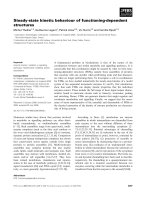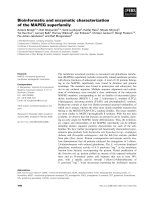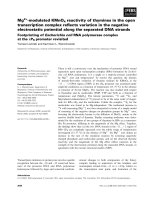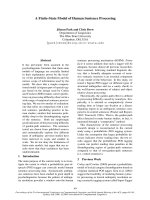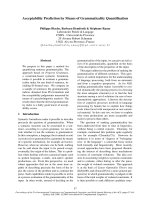Báo cáo khoa học: "Electrostatic dusting: efficient technique of pollination in larch" doc
Bạn đang xem bản rút gọn của tài liệu. Xem và tải ngay bản đầy đủ của tài liệu tại đây (601.12 KB, 10 trang )
Original
article
Electrostatic
dusting:
an
efficient
technique
of
pollination
in
larch
G
Philippe
P
Baldet
Division
amélioration
génétique
et
pépinières forestières,
Cemagref,
45290
Nogent-sur-Vernisson,
France
(Received
5
December
1995;
accepted
29
March
1996)
Summary -
Electrostatic
pollination
has
been
developed
for
mass
production
of
seeds
of
hybrid
larch
(Larix
x
eurolepis
Henry).
Pollination
occurs
within
a
tank
carried
at
the
front
of
a
tractor
(fig
1).
A
high
voltage
is
maintained
between
the
pollen
dispenser
and
the
tree
to
be
pollinated.
Pollen
charged
with
static
electricity
is
blown
on
the
tree
by
an
electrostatic
gun,
fastened
at
the
top
of
the
tank.
This
technique
favors
pollen
deposition
on
the
flowers
(five
and
15
pollen
grains
per
bract
on
the
average
for
0
and
40
kV,
respectively)
(fig
2,
table
II).
Compared
to
conventional
pollen
blowing,
electrostatic
dusting
enhanced
full
seed
percentage
(32
vs
23%)
without
reduction
in
seed
viability
although
the
amount
of pollen
used
was
much
smaller.
Moreover,
this
technique
involves
less
time
than
the
conventional
method.
However,
seed
set
decreased
from
the
top
to
the
bottom
of
the
crown
(39
and
26%
full
seeds,
respectively)
(table
III).
Manual
utilization
of
an
electrostatic
gun
should
result
in
good
pollination,
judging
by
the
excellent
seed
set
obtained
in
the
branches
situ-
ated
near
the
gun
(table
IV).
pollination
/
pollen
/
electrostatic
dusting
/
Larix
eurolepis
/
Larix
decidua
Résumé -
Le
poudrage
électrostatique :
une
technique
de
pollinisation
efficace
chez
le
mélèze.
La
pollinisation
par
poudrage
électrostatique
a
été
évaluée
dans
un
verger
d’hybridation
de
mélèze
(Larix
x
eurolepis
Henry).
Cette
technique
consiste
à
instaurer
une
forte
tension
entre
le
pistolet
électrostatique
et
l’arbre
à
polliniser
et
à
souffler
du
pollen
chargé
en
électricité
statique.
La
pollini-
sation
a
lieu
dans
une
cuve
portée
sur
tracteur
pour
s’affranchir
du
vent.
Ce
procédé
favorise
le
dépôt
du
pollen
sur
les
fleurs
(1
3 et
1
5 grains
de
pollen
/
bractée
pour
15
et
40
kV,
contre
cinq
grains
/
brac-
tée
sans
électrisation).
La
supériorité
du
poudrage
électrostatique
diminue
du
haut
vers
le
bas
de
l’arbre,
à
mesure
que
l’on
s’éloigne
de
la
source
de
pollen.
Dans
le
bas,
seule
la
tension
de
40
kV
dif-
fère
significativement
de
0
kV.
La
pollinisation
électrostatique
aboutit
à
de
meilleurs
rendements
en
graines
que
la
technique
de
pollinisation
classique
(32%
de
graines
pleines
contre
23%)
sans
perte
de
pouvoir
germinatif tout
en
permettant
une
économie
importante
de
pollen.
Cependant,
le
pourcent-
*
Correspondence
and
reprints
Tel:
(33)
02
38
95
03
30;
fax:
(33)
02
38 95 03
59;
e-mail:
age
de
graines
pleines
décroît
du
sommet
vers
le
bas
de
l’arbre
(de
39
à
26
%).
Sur
les
branches
situées
à
proximité
du
pistolet,
le
rendement
en
graines
est
très
satisfaisant
(48
%
de
graines
pleines)
et
les
variations
entre
branches
et
entre
cônes
sont
plus
faibles
que
dans
le
cas
de
la
pollinisation
classique.
Ces
résultats
rendent
optimiste
quant
à
l’utilisation
manuelle
du
pistolet
électrostatique
en
pollinisation
dirigée.
pollinisation
/
pollen
/
poudrage
électrostatique
/
Larix
eurolepis
/
Larix
decidua
INTRODUCTION
Supplemental
mass
pollination
(SMP)
is
the
broadcast
application
of
pollen
to
female
flowers
that
are
not
isolated
from
airborne
pollen
(Wakeley
et
al,
1966).
It
enables
the
seed
orchard
manager
to
increase
seed
yield
and
to
improve
panmixis
and
genetic
gains,
especially
by
reducing
pollen
contamina-
tion,
self-fertilization
or
by
making
cross-
ings
between
the
best
genotypes
(El-Kass-
aby et al,
1990).
SMP
is
absolutely
necessary
in
French
hybrid
larch
(Larix
x
eurolepis
Henry)
seed
orchards
where
a
lag
between
flowering
of
European
larch
(Larix
decidua
Mill)
and
Japanese
larch
(Larix
kaempferi
Carr)
clones
prevents
natural
hybridization.
In
a
first
step,
a
mechanized
pollen
harvester
has
been
built
to
collect
quickly
large
amounts
of
pollen
(Philippe
and
Baldet,
1992).
In
a
second
step,
improvement
of
the
pollination
method
is
needed
in
order
to
increase
seed
yield
and
to
save
pollen.
The
most
common
technique
of
SMP
consists
of
blowing
pollen,
sometimes
mixed
with
talc,
in
an
air
flow
toward
the
female
inflorescences.
Many
devices
can
be
used:
mechanical
insecticide
dusters,
compressed-
air
paint
sprayers
for
the
pollination
of
indi-
vidual
or
clustered
flowers,
motorized
dusters
operated
from
the
ground
or
from
a
platform
for
larger
scale
treatments
(Bridg-
water
and
Trew,
1981
). More
sophisticated
ways
of
distributing
pollen
have
also
been
attempted
but
without
success,
for
exam-
ple,
via
helicopter
in
Douglas-fir
(Webber,
personal
communication)
and
radio-
controlled
model
helicopter
in
Scots
pine
(Hadders, 1984).
A
new
technique,
electrostatic
dusting,
has
been
developed
in
Cemagref
since
1988.
This
method
is
used
in
industry
to
coat
objects
of
unusual
form,
such
as
frames.
Paint
particles
are
charged
with
static
elec-
tricity
and
blown
by
an
electrostatic
gun
toward
a
grounded
object
to
be
painted.
It
results
in
a
strong
attraction,
the
object
being
painted
uniformly
with
minimal
paint
loss
owing
to
the
’electrostatic
wrapping
effect’.
In
addition,
the
particles
of
paint
are
guided
toward
the
most
conductive
parts
of
the
object
when
it
is
made
of
several
materials.
As
resistivity
measurements
proved
that
larch
flowers
were
more
conductive
than
the
old
branches
or
the
trunk
(Philippe
and
Valadon,
1992),
it
was
to
be
expected
that
pollen
would
be
attracted
specifically
by
the
flowers.
Therefore,
this
industrial
process
has
been
transposed
to
pollination
with
the
coated
object
being
the
flower
and
the
coat-
ing
particles
being
the
pollen
grains.
Feasibility
tests
demonstrated
that
larch
pollen
characteristics
were
compatible
with
electrostatic
coating
technology.
Prelimi-
nary
trials
indicated
that
this
technique
did
not
affect
pollen
quality
and
that
a
fair
num-
ber
of
pollen
grains
were
visible
on
the
flower
bracts
and
on
the
stigmatic
flaps
(Philippe
and
Valadon,
1992).
The
purpose
of
the
present
work
was
i)
to
quantify
the
effect
of
voltage
intensity
on
pollen
depo-
sition
on
flowers
situated
at
different
places
in
the
crown;
ii)
to
ascertain
whether
elec-
trostatic
dusting
was
detrimental
to
ovules
and
finally
iii)
to
compare
seed
yields
obtained
by
electrostatic
dusting
with
those
obtained
by
the
conventional
pollination
technique.
MATERIALS
AND
METHODS
Pollinator
The
pollinator
was
carried
by
a
four-wheel
drive
tractor
and
composed
of
three
main
components:
a
front
pollination
tank
designed
to
encompass
the
tree,
the
electrostatic
dusting
device
and
an
energy
unit
(fig
1).
The
pollination
tank
was
made
of
the
same
materials
and
had
the
same
shape
as
the
pollen
harvester
tank
(Baldet
and
Philippe,
1993).
Nylon
nuts
and
screws
were
added
in
order
to
prevent
loss
of
current.
After
the
tree
was
enclosed
within
the
tank,
a
sharp
metallic
tip
grounded
to
the
tank
frame
and
to
the
tractor
was
pushed
into
the
base
of
the
trunk
to
ensure
electrical
conductivity
between
the
tree
and
the
positive
pole
of
the
elec-
trostatic
device.
The
tractor
itself
was
grounded
by
a
heavy
steel
chain.
The
electrostatic
dusting
device
was
com-
posed
of
three
components:
i)
a
control
module
in
the
tractor
cab,
which
regulated
the
voltage
and
which
also
adjusted
pressure
and
flow
rates
of
the
air
stream
that
blew
the
pollen;
ii)
a
pollen
conveyer,
fixed
to
the
tank,
which
delivered
pollen
to
the
gun;
iii)
an
electrostatic
gun
(Rans-
burg-Gema,
model
AP
761)
fastened
on
the
top
of
the
tank
and
driven
by
a
rotating
arm.
At
each
rotation
(20
s
duration),
it
blew
1.25
g
of
pollen
in
a
dry
air
flow
(1
bar
pressure).
An
integrated
cascade
power
supply
maintained
the
high
volt-
age,
adjustable
from
15
to
80 kV.
A
nozzle
situ-
ated
at
the
tip
of
the
gun
contained
four
elec-
trodes
which
electrostatically
charged
pollen
grains.
The
energy
unit,
located
at
the
rear,
drew
elec-
tricity
and
generated
compressed
dry
air.
It
com-
bined
an
air
compressor
with
an
air
drier,
both
electrically
powered
from
a
generator
driven
by
the
tractor’s
power
train.
Experiment
1
Treatments
Experiment
1 compared
three
voltages:
0
kV
(uncharged
pollen),
15
kV
and
40
kV.
Pollen
of
Japanese
larch
was
blown
on
a
single
target
tree
(2.5
g
per
application),
a
3
m
tall
hybrid
larch.
Determination
of pollination
efficiency
was
based
on
the
average
number
of
pollen
grains
per
bract
(per
flower)
on
the
same
set
of
20
flowers
dis-
tributed
over
the
whole
tree
(situated
at
40-210
cm
from
the
electrostatic
gun).
Only
those
pollen
grains
located
on
the
visible
part
of
the
upper
side
of
the
bracts
were
counted.
Thus,
pollen
deposited
on
the
lower
side
of
the
bracts
and
pollen
that
may
have
landed
directly
on
the
stigmatic
hairs
were
not
taken
into
account.
Between
applications,
pollen
present
on
the
sam-
pled
flowers
was
carefully
removed
by
blowing
gently
compressed
air.
Absence
of
remaining
pollen
was
checked.
Each
treatment
was
repli-
cated
once.
Statistical
analysis
Data
were
analyzed
by
the
Statgraphics
proce-
dure.
The
sampled
flowers
were
grouped
into
three
crown
sections
including
eight
flowers
at
the
top
(situated
at
a
distance
of
40-95
cm
from
the
pollen
source),
seven
flowers
in
the
middle
(110-130
cm)
and
five
flowers
at
the
bottom
(160-210
cm).
Mean
numbers
of
pollen
grains
per
bract
(per
flower)
were
subjected
to
the
analysis
of
vari-
ance
according
to
the
following
linear
model:
where
Y
ijkl
= the
response
variable,
ie,
the
mean
number
of pollen
grains/bract
of
flower
1 in
repli-
cation
k
in
crown
section j
in
treatment
i;
μ
=
the
grand
mean;
Vi
=
the
effect
of
voltage
for
i
=
1,
2,
3;
Cj
= the
effect
of
crown
section
for j
=
1,
2, 3;
Rk
= the
effect
of
replication
for
k
=
1,
2;
V*C
ij
,
V*R
ik
,
C*Rjk,
V*C*R
ijk
=
the
main
effect
interactions
and
e
ijkl
= the
experimental
error.
Prior
to
analysis,
mean
number
of pollen
grains
was
transformed
by
the
cube
root
to
con-
form
to
assumptions
of
ANOVA.
Means
were
compared
with
the
Tukey
test.
Experiment
2
Seed
orchard
The
pollinator
was
tested
in
a
0.7
ha
seed
orchard
located
in
’Les
Barres’,
in
the
center
of
France.
It
included
114
grafts
of
a
self-incompatible
clone
of
European
larch
(coded
V44),
used
as
maternal
parent,
and
150
grafts
of
clones
of
Japanese
larch,
used
as
pollen
producers.
Grafts
were
planted
in
1976-1977,
at
5
x
5
m
spacings
and
they
have
been
pruned
regularly.
In
1992,
the
year
of
the
experiment,
the
average
tree
was
3
m
high
and
2
m
wide.
Cone
production
was
excellent,
thanks
to
girdling
+
gibberellin
(GA4/7
)
treatments
in
1991.
Treatments
Three
treatments
were
compared
on
the
V44
clone:
i)
manual
pollination
of
13
grafts
by
the
conventional
method,
using
compressed
air;
ii)
electrostatic
pollination
of
ten
grafts
(2.5
g
per
application,
40
kV);
iii)
a
control
treatment
intended
to
ascertain
whether
the
high
tension
inherent
in
electrostatic
dusting
did
not
disturb
normal
reproduction
events.
Four
grafts
were
pollinated
as
in
treatment
1,
then
were
submitted
to
a
40
kV
tension
in
the
pollinator
(without
addi-
tional
blowing
of
pollen).
Pollen
was
a
polymix
of
56
clones
of
Japanese
larch
(6-7%
moisture
content).
In
treatments
1
and
3,
it
was
diluted
with
cedar
pollen
(1:1
vol-
ume),
a
usual
practice
in
Cemagref,
in
order
to
save
larch
pollen.
Cedar
pollen,
which
is
easy
to
collect
in
great
quantities,
was
preferred
to
talc
which
sometimes
damaged
flowers.
As
electro-
static
dusting
makes
pollination
possible
even
with
small
amounts
of
pollen,
the
pollen
used
in
treatment
2
was
pure.
Grafts
included
in
treatments
1
and
3
were
pollinated
on
17,
20
and
25
March
1992.
Daily
counts
of
flowers
(860
flowers
distributed
on
36
trees)
indicated
that
72, 87
and
96%
of
the
flow-
ers
had
emerged
at
these
respective
dates.
Grafts
included
in
treatment
2
were
pollinated
twice
only,
on
17
and
20
March.
This
period
was
char-
acterized
by
favorable
climatic
conditions
for
pollination
(sunny
weather,
low
air
moisture,
limited
wind).
For
each
treatment,
quantity
of
pollen
used
and
working
time
were
determined.
Cone
collection
Cones
were
collected
according
to
different
pro-
cedures,
depending
on
the
objectives
pursued
(table
I).
Determination
of seed
set
and
germination
capacity for
each
tree;
homogeneity
of seed
set
within
the
tree
In
treatments
2
and
3,
cones
were
sampled
in
the
upper,
middle
and
lower
crown
of
all
the
grafts
in
order
i)
to
determine
the
percentage
of full
seeds
and
the
germination
percentage
for
each
tree
(taking
into
account
the
number
of
cones
pre-
sent
in
each
crown
section
of
each
tree)
and
ii)
to
study
variations
of
seed
set
among
crown
sec-
tions.
In
treatment
1,
previous
results
had
shown
that
seed
set
did
not
vary
within
the
tree.
There-
fore,
only
three
grafts
were
harvested
on
crown
section
basis
as
a
control
and
the
ten
remaining
grafts
were
harvested
in
bulk.
Assessment
of electrostatic
dusting
efficiency
in
the
case
of manual
utilization
of the
electrostatic
gun
If
the
electrostatic
gun
was
disconnected
from
the
machine
and
used
manually,
the
operator
would
direct
alternatively
the
pollen
flow
toward
groups
of flowers
or
flowering
branches
as
in
treatment
1.
In
order
to
predict
the
efficiency
of
this
method,
we
compared
the
effect
of
treat-
ments
1
and
2
on
flowers
situated
near
the
pollen
source.
In
both
treatments,
cones
were
collected
from
the
top
branches,
located
in
the
upper
part
of
the
upper
crown
section.
Mean
percentage
of
full
seeds
as
well
as
variations
of
seed
set
between
branches
and
between
cones
of
the
same
branch
were
studied.
Seed
analysis
The
percentage
of
full
seeds
was
determined
by
cutting
200
seeds
per
sample
(or
the
totality
of
the
seeds
when
cones
were
collected
individually).
Germination
percentage
was
estimated
by
germinating
300
to
700
seeds
per
tree
(full
and
empty
mixed),
without
prechilling,
on
filter
paper,
in
an
incubator
set
at
alternating
temperatures
of
30
°C
(8 h)
and
20
°C
(16
h).
Light
(25
μmol·cm
-2·s-1
)
was
provided
during
the
high
temperature
period.
A
seed
was
considered
ger-
minated
when
the
root
length
reached
at
least
three
times
the
seed
length.
Germinated
seeds
were
counted
and
removed
on
days
6,
10,
17
and
19.
At this
point,
all the
seeds
that
failed
to
ger-
minate
were
cut
in
order
to
determine,
for
each
tree, the
number
of
full
seeds
put
in
the
incuba-
tor.
Germination
percentage
was
based
on
the
number
of
full
seeds
(number
of
germinated
seeds
x
100/number
of full
seeds).
Statistical
analysis
In
a
first
step,
mean
percentage
of
full
seeds
per
tree and
mean
germination
rate
per
tree
of
the
27
trees
included
in
the
experiment
were
ana-
lyzed.
For
trees
harvested
on
a
crown
section
basis,
mean
percentage
of
full
seeds
was
calcu-
lated
by
taking
into
account the
number
of
cones
produced
in
each
crown
section
of
each
tree.
Data
were
subjected
to
ANOVA
according
to
the
following
model:
where
Y
ij
=
the
mean
percentage
of
full
seeds
or
the
mean
germination
rate
of
tree j
in
treatment
i;
p
=
the
grand
mean;
Pi
=
the
effect
of
pollination
for
i
=
1,
2,
3
and
e
ij
=
the
experimental
error.
In
a
second
step,
homogeneity
of
seed
set
within
the
tree
was
determined
by
comparing,
in
each
treatment,
the
percentage
of
full
seeds
observed
in
the
three
crown
sections.
ANOVA
was
performed
according
to
the
following
model:
where
Y
ij
= percentage
of
full
seeds
of
tree j
in
crown
section
i;
μ =
the
grand
mean;
Ci
=
the
effect
of
crown
section
for
i
=
1,
2,
3;
e
ij
=
the
experimental
error.
Prior
to
analysis,
the
residuals
were
checked
to
conform
to
assumptions
of
ANOVA.
Means
were
compared
with
the
Scheffe
test.
RESULTS
Experiment
1
Irrespective
of
voltage,
a
gradient
of
polli-
nation
from
the
top
to
the
bottom
of
the
crown
was
observed
(fig
2).
There
was
a
strong
negative
correlation
between
the
mean
number
of
pollen
grains
per
bract
(after
logarithmic
transformation)
and
the
distance
from
the
flowers
to
the
pollen
dis-
penser:
r
=
-0.81,
-0.90
and
-0.90
for
0,
15
and
40
kV,
respectively
(P
<
0.001
in
all
cases).
Flowers
pollinated
with
charged
pollen
received
three
times
more
pollen
(1
3 and
15
grains
per
bract
for
15
and
40
kV,
respec-
tively)
than
those
pollinated
with
uncharged
pollen
(five
grains
per
bract).
This
effect
was
highly
significant
(P <
0.001).
In
addi-
tion,
many
pollen
grains
(not
taken
into
con-
sideration
in
pollen
counts)
could
be
seen
on
the
lower
side
of
the
bracts
after
electri-
cal
pollination,
in
the
top
and,
to
a
smaller
extent,
in
the
middle
part
of
the
tree.
In
each
crown
section,
we
observed
a
significant
effect
of
electrostatic
dusting
except
in
the
lower
crown
where
15
kV
did
not
differ
from
0
kV
(table
II).
Replication
effect
as
well
as
interactions
between
replication
and
voltage
and
replication
and
crown
section
were
not
significant.
Experiment
2
Quantity
of pollen
used
and
working
time
Manual
pollination
(treatments
1
and
3)
demanded
16
g
of larch
pollen
per
tree
(7, 7,
and
2
g
on
17,
20
and
25
March,
respec-
tively).
Trees
included
in
treatment
2
received
5
g
of pollen
(2.5
g
on
17
and
20
March).
Manual
pollination
took
5
min
per
graft
on
the
average.
Electrostatic
dusting
required
only
2
min,
including
tank
positioning,
pol-
lination
and
removal
of
the
tank.
Cone
production
In
treatments
1,
2
and
3,
cone
production
averaged
1 400,
1 100
and
1 500
cones
per
graft,
respectively.
The
differences
were
not
significant.
On
average,
20%
of
the
cones
were
situated
in
the
upper
part
of
the
crown,
45%
in
the
middle
and
35%
in
the
lower
part.
Percentage
of full
seeds
Mean
percentage
of
full
seeds
per
tree
aver-
aged
23,
32 and
24%
in
treatments
1,
2
and
3,
respectively.
The
superiority
of electro-
static
dusting
over
the
conventional
tech-
nique
was
significant
(P
=
0.01).
In
partic-
ular,
seven
of
ten
trees
had
more
than
30%
full
seeds
whereas,
among
the
trees
polli-
nated
manually,
only
four
of
13
reached
this
threshold.
Treatments
1 and
3
did
not
differ
significantly.
As
shown
in
table
III,
no
difference
was
found
among
crown
sections
for
treatment
I
(P
=
0.63)
and
treatment
3
(P
=
0.88).
In
contrast,
electrostatic
dusting
did
not
result
in
homogeneous
seed
yield
since
there
was
a
significant
decrease
from
the
top
to
the
bottom
of
the
crown
(P
<
0.001).
Data
from
three
trees
pollinated
by
elec-
trostatic
dusting
indicated
that
seed
yield
was
even
higher
in
the
top
branches
than
in
the
upper
third
of
the
crown
(48%
full
seeds
vs
41 %).
However,
the
difference
was
clear
for
only
one
tree
where
percentage
of
full
seeds increased
from
32
to
49%.
This
increase
was
hardly
perceptible
for
the
two
other
trees
(43
vs
39%
and
53
vs
52%).
Electrostatic
dusting
resulted
in
more
homo-
geneous
seed
set
in
the
top
branches
than
manual
pollination,
interbranch
and
inter-
cone
variations
being
lower
(table
IV).
Seed
germination
Mean
germination
percentages
per
tree
were
79,
78
and
82%
for
treatments
1,
2
and
3,
respectively.
Differences
were
not
signifi-
cant
(P
=
0.63).
Intermediate
germination
percentages,
obtained
on
days
6,
10
and
17,
did
not
differ
significantly,
indicating
that
germination
speed
was
similar
in
the
three
treatments.
DISCUSSION
Experiment
1
clearly
showed
that electro-
static
effect
favored
pollen
deposition
on
flowers.
Electrostatic
dusting
resulted
in
three
times
more
pollen
on
the
flowers
than
uncharged
pollen
blowing
(15
and
five
pollen
grains
per
bract,
respectively).
How-
ever,
the
quantity
of pollen
that
settled
on
the
bracts
varied
strongly
according
to
the
posi-
tion
of
the
flowers
within
the
crown,
the
nearest
from
the
pollen
source
being
polli-
nated
more
efficiently.
Although
15
and
40
kV
gave
similar
results
(13
and
15
grains
per
bract,
respec-
tively),
40
kV
led
to
more
homogeneous
distribution
of
pollen
than 15 kV. In
partic-
ular,
only
40
kV
differed
significantly
from
0
kV
in
the
lower
crown.
On
the
other
hand,
a
previous
experiment
demonstrated
that
70
kV
resulted
in
more
heterogeneous
pol-
lination
than
lower
voltages
(Philippe
and
Valadon,
1992).
Therefore,
40
kV
proved
to
be
the
most
suitable
voltage.
Although
lack
of
pollination
is
a
major
cause
of
empty
seeds
in
larch
(Kaji,
1974;
Hall
and
Brown,
1977;
Owens
and
Molder,
1979; Kosinski,
1985,
1986),
good
pollina-
tion
is
only
the
first
link
of
the
chain
that
leads
to
seed
production.
In
particular,
it
was
important
to
ensure
that
electrostatic
dusting
did
not
disrupt
normal
reproduction
(meiosis,
female
gametophyte
development,
fertilization,
embryo
development).
Exper-
iment
2
indicated
that
the
high
tension
inher-
ent
in
this
technique
did
not
prevent
viable
seed
formation.
Trees
included
in
treatments
1
and
3
were
characterized
by
similar
seed
yields
(23
and
24%
full
seeds,
respectively)
and
similar
germination
percentages
(79
and
82%,
repectively).
In
addition,
variations
in
seed
set
among
crown
sections
were
not
sig-
nificant
in
both
treatments,
indicating
that
the
upper
flowers,
potentially
in
danger
owing
to
their
proximity
to
the
electrostatic
gun,
were
not
affected
by
electrostatic
effects.
Electrostatic
dusting
resulted
in
improved
seed
yield.
Percentage
of
full
seeds
was,
on
the
average,
40%
higher
than
that
obtained
by
manual
pollination
(32
vs
23%)
although
it
used
three
times
less
pollen
per
tree.
Con-
trary
to
manual
pollination,
a
significant
decrease
in
seed
set
from
the
top
to
the bot-
tom
of
the
crown
was
observed
with
elec-
trostatic
dusting
(39,
32
and
26%
full
seeds
in
the
upper,
middle
and
lower
crown,
respectively).
It
is
consistent
with
the
gra-
dient
of
pollination
observed
in
experiment
1.
Nevertheless,
whatever
the
crown
sec-
tion,
seed
set
was
greater
than
or
equal
to
that
obtained
by
the
manual
dusting.
Ulti-
mately,
the
full
seeds
produced
by
both
tech-
niques
had
satisfactory
germination
per-
centages
(78
and
79%
for
electrical
and
manual
pollination,
respectively).
The
study
of
seed
set
in
the
branches
sit-
uated
near
the
electrostatic
gun
gave
a
good
idea
of
electrostatic
dusting
efficiency
if
the
gun
was
to
be
operated
by
hand.
Compared
to
the
conventional
technique,
it
resulted
in
more
homogeneous
seed
set
among
branches
and
cones
(table
IV).
Moreover,
percentage
of
full
seeds
as
high
as
48%
can
be
regarded
as
excellent
in
larch
(Hall
and
Brown,
1977;
Kosinski,
1982;
Hall,
1985;
Kosinski,
1985).
For
branches
located
near
the
electro-
static
gun,
it
seems
that
only
limited
gain
in
seed
yield
can
be
obtained
by
further
improvement
in
pollination,
at
least
for the
clone
used
in
the
present
seed
orchard.
Firstly,
the
increase
in
seed
set
from
the
upper
third
of
the
crown
to
the
top
branches
was
not
clear
for
the
two
trees
character-
ized
by
high
seed
set
in
the
upper
crown
section
(39
and
52%
full
seeds),
whereas
pollen
deposition
should
have been
better
in
the
top
branches.
Secondly,
if
one
ignores
one
exceptional
cone
which
contained
79%
full
seeds,
the
percentage
of
full
seeds
per
cone
in
the
top
branches
never
rose
above
60%
although
huge
amounts
of
pollen
could
be
seen
on
most
of
the
flowers.
This
indi-
cates
that
the
quantity
of
pollen
is
no
longer
a
limiting
factor
when
it
exceeds
a
certain
threshold.
Formation
of
empty
seeds
must
be
connected
with
factors
other
than
pollina-
tion,
such
as
female
gametophyte
degener-
ation,
failure
of
fertilization
or
embryo
abor-
tion
(Hall
and
Brown,
1977;
Owens
and
Molder,
1979;
Kosinski,
1985,
1986;
Owens,
1995).
A
better
understanding
of
prezygotic
and
postzygotic
events
and
devel-
opment
of
better
tools
to
evaluate
pollen
viability
would
help
to
reduce
the
high
per-
centage
of
empty
seeds
that
is
not
due
to
pollination
failure.
At
pollination
time
in
1992,
air
humidity
was
low,
which
was
favorable
to
electrical
pollination.
Further
work
is
needed
to
ascer-
tain
whether
efficiency
of
electrostatic
dust-
ing
is
affected
by
climatic
conditions,
and
air
hygrometry
in
particular.
ACKNOWLEDGMENTS
The
authors
wish
to
thank
the
Cemagref
staff
in
Montoldre
(France),
who
actively
participated
in
the
construction
of
the
pollinator
and
Rans-
burg-Gema
Company
for
technical
advice.
They
express
also
their
gratitude
to
JD
Boyé
for
field
work
and
to
M
Bonnet-Masimbert
and
P
Von
Aderkas
for
their
advice
and
for
reviewing
the
manuscript.
REFERENCES
Baldet
P,
Philippe
G
(1993)
Mechanized
pollen
har-
vesting
in
larch
seed
orchards.
Tree
Planters’
Notes
44, 141-145
Bridgwater
FE,
Trew
IF
(1981)
Supplemental
mass
pollination.
In:
Pollen
Management
Handbook
(EC
Franklin,
ed),
Agriculture
Handbook
number
587, 52-57
El-Kassaby
YA,
Edwards
DGW,
Cook
C
(1990)
Impact
of
crop
management
practices
on
seed
yield
in
a
Douglas-fir
seed
orchard.
Silvae
Genet
39,
226-
230
Hadders
G
(1984)
Supplemental
and
controlled
mass
pollination
in
seed
orchards
of
Scots
pine
(Pinus
sylvestris
L).
In:
1984
Arsbok,
Föreningen
Skogsträdsförädling.
Institutet
for
Skogsförbät-
tring, 47-64
Hall
JP
(1985)
Variation
in
seed
quantity
and
quality
in
two
grafted
clones
of
European
larch
(Larix
decidua
Mill).
Silvae
Genet
34, 51-56
Hall
JP,
Brown
IR
(1977)
Embryo
development
and
yield
of seed
in
Larix.
Silvae
Genet
26,
77-84
Kaji
K
(1974)
On
the
pollination
and
development
of
ovules,
and
on
the
sterility
of
seeds
in
Japanese
larch
(Larix
leptolepis
Gord).
Bulletin
of the
Hokkaïdo forest
experiment
station
n°
12,
Bibai,
Hokkaïdo,
Japan,
10
p
Kosinski
G
(1982)
Genetic
load
in
empty
seeds
of
European
larch
(Larix
decidua
Mill).
Arboretum
Kornickie,
Rocznik
XXVI,
231-236
Kosinski
G
(1985)
Empty
seed
production
in
Euro-
pean
larch
(Larix
decidua
Mill).
For
Ecol
Man-
age,
19, 241-246
Kosinski
G
(1986)
Megagametogenesis,
fertilization,
and
embryo
development
in
Larix
decidua.
Can
J
For Res
16,
1301-1309
Owens
JN
(1995)
Reproductive
biology
of
larch.
In:
Proc
IUFRO
Symposium
on
Ecology
and
Man-
agement
of Larix
Forerts:
A
Look
Ahead
(WC
Schmidt,
KJ
McDonald,
eds),
Whitefish,
MT,
USA,
5-9
October
1992, 97-109
Owens
JN,
Molder
M
(1979)
Sexual
reproduction
of
Larix
occidentalis.
Can
J
Bot
57, 2673-2690
Philippe
G,
Baldet
P
(1992)
Mechanized
pollen
har-
vesting
with
a
view
to
hybrid
larch
seed
produc-
tion.
Ann
Sci
For
49, 297-304
Philippe
G,
Valadon
A
(1992)
Control
of
the
various
steps
leading
to
hybrid
larch
(Larix
X
eurolepis
Henry)
seed
production:
recent
advances
in
French
seed
orchards.
In:
Proc
IUFRO
Working
Party
S2.02-07
’Larch
Provenances
and
Breeding’,
(H
Weisgerber,
ed),
Sept
5-12
1992,
Berlin,
Prague,
126-135
Wakeley
PC,
Wells
OO,
Campbell
TE
(1966)
Mass
production
of
shortleaf
x
slash
pine
hybrids
by
pol-
linating
unbagged
female
flowers.
In:
Proc
2nd
Genetics
Workshop
of
Soc
Am
Foresters
and
7th
Lake
States
For
Tree
Improv
Conf,
Res
Pap
NC-6,
78-79




